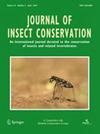Across the firefly-verse: comparison of niche suitability of an exotic firefly in its native and colonized range
IF 1.9
3区 农林科学
Q2 ENTOMOLOGY
引用次数: 0
Abstract
Abstract Photinus signaticollis Blanchard, 1846 (Coleoptera: Lampyridae) is a firefly native to South America and recently established in Europe. Since 2016, this firefly has colonized the northeastern part of the Iberian Peninsula and crossed the Pyrenees to reach southern France in 2019. The larvae of this firefly feed on earthworms, so a high density of this species could negatively impact this key group in soil processes and agriculture. The precise extent of colonization, the environmental niche and the potential range expansion in non-native areas are currently unknown. Using species distribution models, we have found the high suitability areas across Europe where P. signaticollis may become established if introduced. Interestingly, using only South American records and associated conditions modelling it can be strongly predicted where the species is currently found in Europe. Despite a few propagules of P. signaticollis detected in very unsuitable areas of Spain were no longer detected after their initial observation, the climatic niche overlap between South America and Europe populations appeared to be very low. In our case, this pattern is more likely to reflect a high unfilled niche rather than a niche expansion or niche shift, because many occupied areas in South America possess a climate not occurring in Europe. Among the considered variables, we furthermore found that only the temperature seasonality appeared to be the same in both native and European areas and relevant in the models, suggesting that it may represent the main limiting factor for establishing this firefly.穿越萤火虫:一种外来萤火虫在其本地和殖民地范围内的生态位适宜性的比较
摘要/ Abstract摘要:Photinus signaticollis Blanchard, 1846(鞘翅目:Lampyridae)是一种原产于南美洲,最近在欧洲发现的萤火虫。自2016年以来,这只萤火虫一直在伊比利亚半岛东北部定居,并于2019年越过比利牛斯山脉到达法国南部。这种萤火虫的幼虫以蚯蚓为食,因此这种物种的高密度可能会对土壤过程和农业中的这个关键群体产生负面影响。殖民化的确切程度、环境生态位和在非原生地区的潜在范围扩张目前尚不清楚。利用物种分布模型,我们发现了整个欧洲的高适宜性地区,如果引入signaticollis,可能会在那里建立起来。有趣的是,仅使用南美的记录和相关的条件建模就可以强有力地预测该物种目前在欧洲的发现位置。尽管在西班牙非常不适宜的地区发现了一些P. signaticollis的繁殖体,但在最初的观察之后不再被发现,南美洲和欧洲种群之间的气候生态位重叠似乎非常低。在我们的案例中,这种模式更可能反映了一个高度未填充的生态位,而不是生态位扩张或生态位转移,因为南美洲许多被占领的地区拥有欧洲没有的气候。在考虑的变量中,我们进一步发现只有温度季节性在本地和欧洲地区似乎是相同的,并且在模型中相关,这表明它可能是建立这种萤火虫的主要限制因素。
本文章由计算机程序翻译,如有差异,请以英文原文为准。
求助全文
约1分钟内获得全文
求助全文
来源期刊
CiteScore
3.60
自引率
10.50%
发文量
76
审稿时长
6 months
期刊介绍:
The Journal of Insect Conservation is an international journal devoted to the publication of articles concerned with the conservation of insects and related invertebrates. The Journal of Insect Conservation publishes papers on all aspects of conservation and biodiversity related to the insects and closely related groups such as Arachnids and Myriapods, including ecological work which has conservation implications. Research papers may address the subject at the community, population or species level, may cover aspects of behaviour, taxonomy or genetics, be theoretical or practical, and be local or global in nature. Review articles are welcome as well as points of view which are likely to stimulate debate. From time to time the journal will publish Special Issues on specific subject areas which are the focus of current research. Proposals for such issues are welcome.

 求助内容:
求助内容: 应助结果提醒方式:
应助结果提醒方式:


